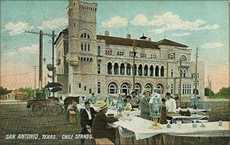|
By
most accounts, William Gerald Tobin’s career as a Texas Ranger left
a lot to be desired. But he had an idea that left Texas, and the Southwest,
an enduring gastronomical legacy.
Born in South Carolina in 1833, Tobin came to Texas 20 years later
with his brother Dan, settling in San
Antonio. He soon married well, hitching up with Josephine Smith,
daughter of former city mayor John William Smith.
He first rode as a ranger in 1855, a year later serving as city marshal
of the Alamo City.
In 1859, hearing that rancher-bandit-Mexican patriot Juan Napoleon
Cortina had raided Brownsville,
Tobin decided to raise his own company of volunteers and march to
the aid of the terrified Valley community. On his way south, he sent
a letter to Gov. E.M. Pease offering his services as a Ranger captain.
The governor took him up on his offer and gave him an official commission.
Not long after Tobin and his rangers rode into Brownsville,
the situation got even worse. A party of vigilantes – historians today
suspect Tobin’s men – lynched a Cortina officer who had been captured
before the arrival of the Rangers. That made Cortina so mad he threatened
to burn the whole town down. Brownsville
survived, but it took another company of Rangers under the celebrated
John “Rip” Ford plus elements of the U.S. Army to squelch Cortina’s
mini-war on South Texas.
Despite his lackluster duty in the Valley, Tobin got swept up in the
martial spirit at the outset of the Civil War and gained a commission
as a captain of Confederate Army. He survived the war and returned
to San Antonio.
In the 1870s, he turned his attention to what may have been his strongest
suit: business. He leased a structure known as the Vance Building
and opened a hotel he called the Vance House.
Somewhere
along the way, he acquired a taste for a particular dish favored in
San Antonio and South
Texas. That appetite on Tobin’s part would play a part in this
food’s Americanization – and Texas iconization.
By the early 1880s, he had hit his entrepreneurial stride in the Alamo
City. And then he had his grand idea: Canning chili. In 1881, Tobin
negotiated a contract with the federal government to sell canned chili
con carne to the Army and Navy.
Carne, of course, is Spanish for meat. One would assume that beef
would have been the meat that Tobin used in his product, but he opted
for goat meat.
Having figured a way to make money off the government, which is close
to alchemy, Tobin opened a chili con carne processing plant and canning
operation. But just as his venture had begun to take off, he died
on July 28, 1884. (No truth to the rumor that he died of chronic indigestion.)
Soon after his death, the business went bust.
In fairness to history, it must not be intimated that this former
Texas Ranger invented chili. All he did was think to can it.
Some say chili came from the Spanish, who supposedly found that antelope
meat tasted better when cooked with onions, tomatoes and chili peppers.
Others claim that chili originated over the campfires of California-bound
Texans during the 1849 gold rush.
More likely, Tejanos – Mexican of Texas origin -- developed chili
as a way to get a lot out of a little meat. |
 |
Chili stands
in San Antonio in 1908
Postcard courtesy www.rootsweb.com/ %7Etxpstcrd/ |
No matter how chili came to be, long before Texas
became a state in 1845, Mexican women sold chili and tortillas on
the streets of San Antonio.
Eventually these street vendors came to be known as “Chili Queens,”
and they lasted until health regulations forced them out of business.
The next evolutionary development was the invention of chili powder,
which came about 1890. Three years later, Texas
introduced the rest of the nation to chili at the Columbian Exposition
in Chicago.
Not until 1921 did someone finally get around to following up on Tobin’s
idea of canning chili. That was Lyman T. Davis of Corsicana,
who started peddling canned chili from the back of a wagon. He named
his product after Kaiser Bill, his pet wolf.
Wolf Brand Chili, of course, remains on the grocery shelf today. But
nowhere on the label is any credit given to former Ranger William
Tobin for his Texas-sized idea -- putting chili in a can.
© Mike Cox
"Texas Tales"
- January 31, 2005 Column
See Texas Food |
| Books
by Mike Cox - Order Here |
|
|
